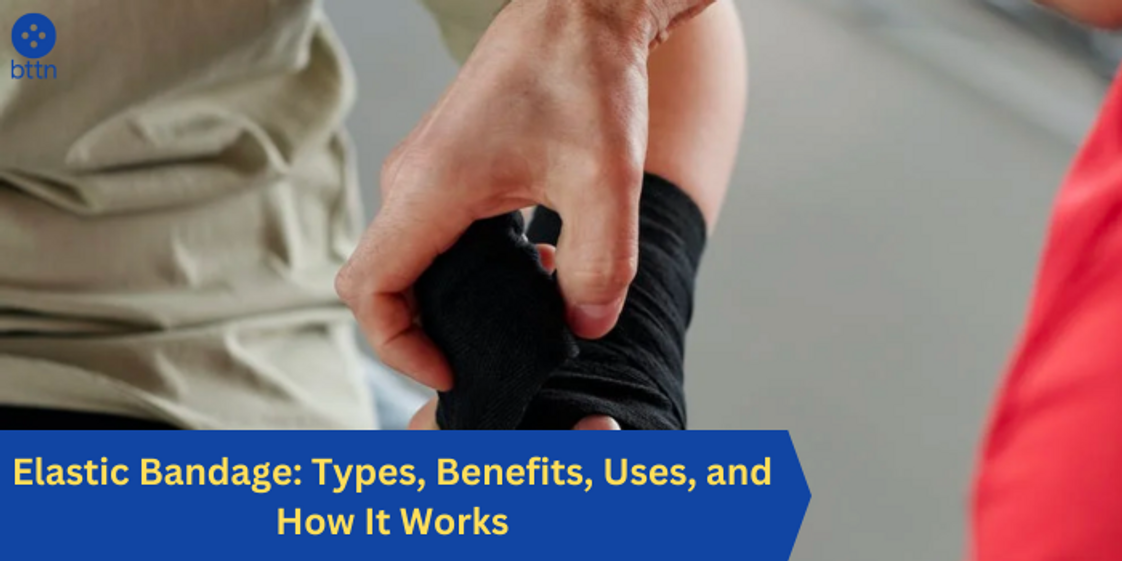
Elastic Bandage: Types, Benefits, Uses, and How It Works
Posted by Pankaj Dhiman on Oct 12th 2023
When it comes to minor injuries, sprains, or strains, an elastic bandage is a simple yet effective tool that can make a world of difference. These stretchy, versatile wraps are a staple in any first-aid kit, but do you really know how they work, what types are available, and the many benefits they offer? In this guide, we'll unravel the mystery behind elastic bandages, helping you understand their uses, advantages, and more.
Types of Elastic Bandages
Elastic bandages come in various types, each designed for specific purposes. Here are some of the most common varieties:
1. Cohesive Bandages:
- Cohesive bandages, also known as self-adhering or self-sticking bandages, are perfect for situations where you need a secure, non-slip hold. They adhere to themselves without the need for clips or pins, making them a go-to choice for wrapping sprained wrists or ankles.
2. Crepe Bandages:
- Crepe bandages are stretchable, lightweight, and breathable. They provide gentle support for minor injuries and are often used for strains or muscle sprains. Their texture resembles crepe paper, hence the name.
3. Elasticated Tubular Bandages:
- These tubular bandages are designed to slide over limbs like sleeves, making them ideal for wrapping larger areas or irregularly shaped body parts. They offer uniform compression and are commonly used for dressing retention.
4. Compression Bandages:
- Compression bandages are specifically designed to promote blood circulation and reduce swelling. They are widely used for medical conditions like edema, venous ulcers, and deep vein thrombosis. These bandages are available in various compression levels, depending on the severity of the condition.
5. High Compression Bandages:
- These bandages provide firmer support and are typically used for more serious medical conditions, such as lymphedema or chronic venous insufficiency. They offer higher pressure and require proper medical guidance for application.
Benefits of Elastic Bandages
Now that we've covered the different types of elastic bandages, let's dive into the numerous benefits they offer:
1. Support and Stability:
- The primary purpose of elastic bandages is to provide support and stability to injured or weak body parts. They help reduce movement, preventing further damage to the injured area.
2. Compression:
- Elastic bandages offer controlled compression. This helps reduce swelling by facilitating proper blood circulation and lymphatic drainage. The compression also provides pain relief in cases of sprains and strains.
3. Versatility:
- With various types available, elastic bandages are versatile tools. They can be used for different injuries and medical conditions, making them a valuable addition to any first-aid kit.
4. Breathability:
- Many elastic bandages are designed to be breathable, preventing skin irritation and allowing the skin to breathe during the healing process.
5. Ease of Use:
- Elastic bandages are user-friendly and do not require special training for application. They are suitable for both medical professionals and everyday individuals.
6. Cost-Effective:
- When it comes to cost, elastic bandages are an economical choice for minor injuries and medical conditions that require compression therapy. They can be easily replaced when soiled or worn out.
Common Uses of Elastic Bandages
Now that you understand the advantages of elastic bandages, let's explore some common uses for these versatile wraps:
1. Sprains and Strains:
- Elastic bandages are often used to wrap and support sprained ankles, wrists, or other joints. The compression helps reduce pain and swelling, while the stability they provide aids in the healing process.
2. Sports Injuries:
- Athletes frequently use elastic bandages to prevent or manage injuries during physical activities. These bandages can be applied to provide extra support to vulnerable areas like the knees, elbows, or shoulders.
3. Post-Surgery Support:
- After certain surgeries, patients may require compression to aid in healing and reduce post-operative swelling. Elastic bandages offer a convenient solution for this purpose.
4. Dressing Retention:
- Elasticated tubular bandages are excellent for holding dressings in place. They are easy to slide over a limb, securing the dressing without the need for additional tape or clips.
5. Edema and Lymphedema:
- Compression bandages, including high-compression options, are used in the management of conditions like edema and lymphedema. These conditions involve fluid retention and swelling, and proper compression helps alleviate the symptoms.
6. Venous Ulcers:
- Patients with venous ulcers often benefit from the use of compression bandages. The pressure exerted by these bandages aids in healing and prevents the recurrence of ulcers.
How Elastic Bandages Work
Understanding how elastic bandages work can help you make the most of their benefits. When properly applied, these bandages exert pressure on the wrapped area, and this pressure serves several purposes:
- Compression: The bandage compresses the blood vessels and tissues beneath, reducing the flow of blood to the injured area. This controlled compression helps minimize swelling and pain.
- Support: The bandage provides external support to the injured or weak body part, limiting movement and preventing further damage. It acts as a "second skin" for the affected area.
- Promotion of Healing: By reducing swelling, improving blood circulation, and providing support, elastic bandages facilitate the body's natural healing processes. This can lead to a faster and more comfortable recovery.
Final Thought
FIn conclusion, elastic bandages are essential tools for managing minor injuries, providing support, and aiding in the recovery process. With various types available, you can choose the one that suits your specific needs. From sprains and strains to medical conditions like edema, these versatile wraps have a wide range of applications. Understanding how elastic bandages work and their numerous benefits can help you make the most of these simple yet effective tools in your everyday life. So, don't forget to keep a few elastic bandages in your first-aid kit for those unexpected moments when they can make a world of difference.





























































